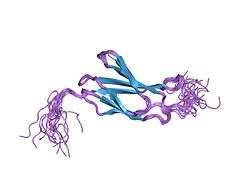Tenascin X
A member of the tenascin family, tenascin X (TN-X) also known as hexabrachion-like protein is a glycoprotein that is expressed in connective tissues including skin, joints and muscles. In humans, tenascin X is encoded by the TNXB gene.[5]
Gene
This gene localizes to the major histocompatibility complex (MHC) class III region on chromosome 6. The structure of this gene is unusual in that it overlaps the CREBL1 and CYP21A2 genes at its 5' and 3' ends, respectively.[6]
Function
This gene encodes a member of the tenascin family of extracellular matrix glycoproteins. The tenascins have anti-adhesive effects, as opposed to fibronectin which is adhesive. This protein is thought to function in matrix maturation during wound healing.[6]
Clinical significance
Deficiency causes one of the types of Ehlers–Danlos syndrome where collagen density is reduced and elastic fibers are fragmentated.[7]
References
- 1 2 3 ENSG00000236221, ENSG00000229353, ENSG00000229341, ENSG00000233323, ENSG00000231608, ENSG00000206258, ENSG00000168477 GRCh38: Ensembl release 89: ENSG00000236236, ENSG00000236221, ENSG00000229353, ENSG00000229341, ENSG00000233323, ENSG00000231608, ENSG00000206258, ENSG00000168477 - Ensembl, May 2017
- 1 2 3 GRCm38: Ensembl release 89: ENSMUSG00000033327 - Ensembl, May 2017
- ↑ "Human PubMed Reference:".
- ↑ "Mouse PubMed Reference:".
- ↑ Tee MK, Thomson AA, Bristow J, Miller WL (July 1995). "Sequences promoting the transcription of the human XA gene overlapping P450c21A correctly predict the presence of a novel, adrenal-specific, truncated form of tenascin-X". Genomics. 28 (2): 171–8. doi:10.1006/geno.1995.1128. PMID 8530023.
- 1 2 "Entrez Gene: tenascin XB".
- ↑ Zweers, MC; Schalkwijk, J; Van Kuppevelt, TH; Van Vlijmen-Willems, IM; Bergers, M; Lethias, C; Lamme, EN (2005). "Transplantation of reconstructed human skin on nude mice: a model system to study expression of human tenascin-X and elastic fiber components". Cell and Tissue Research. 319 (2): 279–87. doi:10.1007/s00441-004-1011-6. PMID 15558324.
Further reading
- Goepel C (2008). "Differential elastin and tenascin immunolabeling in the uterosacral ligaments in postmenopausal women with and without pelvic organ prolapse". Acta Histochem. 110 (3): 204–9. doi:10.1016/j.acthis.2007.10.014. PMID 18155129.
- Yuan Y, Nymoen DA, Stavnes HT, et al. (2009). "Tenascin-X is a novel diagnostic marker of malignant mesothelioma". Am. J. Surg. Pathol. 33 (11): 1673–82. doi:10.1097/PAS.0b013e3181b6bde3. PMC 2783994. PMID 19738457.
- Egging D, van Vlijmen-Willems I, van Tongeren T, et al. (2007). "Wound healing in tenascin-X deficient mice suggests that tenascin-X is involved in matrix maturation rather than matrix deposition". Connect. Tissue Res. 48 (2): 93–8. doi:10.1080/03008200601166160. PMID 17453911.
- Egging DF, van Vlijmen-Willems I, Choi J, et al. (2008). "Analysis of obstetric complications and uterine connective tissue in tenascin-X-deficient humans and mice". Cell Tissue Res. 332 (3): 523–32. doi:10.1007/s00441-008-0591-y. PMC 2386751. PMID 18335242.
- Kato A, Endo T, Abiko S, et al. (2008). "Induction of truncated form of tenascin-X (XB-S) through dissociation of HDAC1 from SP-1/HDAC1 complex in response to hypoxic conditions". Exp. Cell Res. 314 (14): 2661–73. doi:10.1016/j.yexcr.2008.05.019. PMID 18588874.
- Bristow J, Carey W, Egging D, Schalkwijk J (2005). "Tenascin-X, collagen, elastin, and the Ehlers-Danlos syndrome". American Journal of Medical Genetics. 139C (1): 24–30. doi:10.1002/ajmg.c.30071. PMID 16278880.
- Fellay J, Ge D, Shianna KV, et al. (2009). McCarthy MI, ed. "Common genetic variation and the control of HIV-1 in humans". PLoS Genet. 5 (12): e1000791. doi:10.1371/journal.pgen.1000791. PMC 2791220. PMID 20041166.
- Kamatani Y, Matsuda K, Ohishi T, et al. (2008). "Identification of a significant association of a single nucleotide polymorphism in TNXB with systemic lupus erythematosus in a Japanese population". J. Hum. Genet. 53 (1): 64–73. doi:10.1007/s10038-007-0219-1. PMID 18058064.
- Valdes AM, Thomson G (2009). "Several loci in the HLA class III region are associated with T1D risk after adjusting for DRB1-DQB1". Diabetes Obes Metab. 11. Suppl 1: 46–52. doi:10.1111/j.1463-1326.2008.01002.x. PMC 2755069. PMID 19143814.
- Yu CY (1998). "Molecular genetics of the human MHC complement gene cluster". Exp. Clin. Immunogenet. 15 (4): 213–30. doi:10.1159/000019075. PMID 10072631.
- Endo T, Ariga H, Matsumoto K (2009). "Truncated form of tenascin-X, XB-S, interacts with mitotic motor kinesin Eg5". Mol. Cell. Biochem. 320 (1–2): 53–66. doi:10.1007/s11010-008-9898-y. PMID 18679583.
- Sovio U, Bennett AJ, Millwood IY, et al. (2009). Gibson G, ed. "Genetic determinants of height growth assessed longitudinally from infancy to adulthood in the northern Finland birth cohort 1966". PLoS Genet. 5 (3): e1000409. doi:10.1371/journal.pgen.1000409. PMC 2646138. PMID 19266077.
- Araújo VC, Furuse C, Cury PR, et al. (2008). "Tenascin and fibronectin expression in carcinoma ex pleomorphic adenoma". Appl. Immunohistochem. Mol. Morphol. 16 (1): 48–53. doi:10.1097/PAI.0b013e31802eff1c. PMID 18091320.
- Gudbjartsson DF, Walters GB, Thorleifsson G, et al. (2008). "Many sequence variants affecting diversity of adult human height". Nat. Genet. 40 (5): 609–15. doi:10.1038/ng.122. PMID 18391951.
- Barcellos LF, May SL, Ramsay PP, et al. (2009). Roopenian DC, ed. "High-density SNP screening of the major histocompatibility complex in systemic lupus erythematosus demonstrates strong evidence for independent susceptibility regions". PLoS Genet. 5 (10): e1000696. doi:10.1371/journal.pgen.1000696. PMC 2758598. PMID 19851445.
- McKinnon E, Morahan G, Nolan D, et al. (2009). "Association of MHC SNP genotype with susceptibility to type 1 diabetes: a modified survival approach". Diabetes Obes Metab. 11 (Suppl 1): 92–100. doi:10.1111/j.1463-1326.2008.01009.x. PMC 2755510. PMID 19143821.
- Chapuis J, Hot D, Hansmannel F, et al. (2009). "Transcriptomic and genetic studies identify IL-33 as a candidate gene for Alzheimer's disease". Mol. Psychiatry. 14 (11): 1004–16. doi:10.1038/mp.2009.10. PMC 2860783. PMID 19204726.
- Vignal C, Bansal AT, Balding DJ, et al. (2009). "Genetic association of the major histocompatibility complex with rheumatoid arthritis implicates two non-DRB1 loci". Arthritis Rheum. 60 (1): 53–62. doi:10.1002/art.24138. PMID 19116923.
- Buysschaert ID, Grulois V, Eloy P, et al. (2010). "Genetic evidence for a role of IL33 in nasal polyposis". Allergy. 65 (5): 616–22. doi:10.1111/j.1398-9995.2009.02227.x. PMID 19860791.
- Gudbjartsson DF, Bjornsdottir US, Halapi E, et al. (2009). "Sequence variants affecting eosinophil numbers associate with asthma and myocardial infarction". Nat. Genet. 41 (3): 342–7. doi:10.1038/ng.323. PMID 19198610.
External links
This article incorporates text from the United States National Library of Medicine, which is in the public domain.






